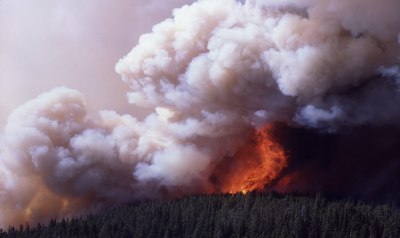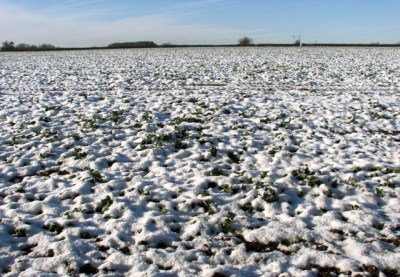
Nuclear war was very much a front-of-mind issue during the fraught political climate of the Cold War era. Since then, atomic sabre rattling has been less frequent, though has never quite disappeared entirely.
Outside of the direct annihilation caused by nuclear war, however, is the threat of nuclear winter. The basic concept is simple: in the aftermath of a major nuclear war, the resulting atmospheric effects could lead to a rapid cooling in global temperatures.
Some say it couldn’t ever happen, while others – including Futurama – suggest with varying degrees of humor that it could help cancel out the effects of global warming. But what is the truth?
Hard data is isn’t really available, as thus far there have been no large-scale nuclear wars for scientists to measure. Several studies have explored the concept of nuclear winter, however, and explored its potential effects.
How Does It Work, Anyway?

The basic concept of nuclear winter is simple. In a large nuclear conflict, where nuclear weapons are used in strategic strikes against urban and industrial areas, large-scale fires would rage out of control. These fires would then loft large amounts of black carbon soot into the upper reaches of the atmosphere. Once there, the smoke particles might then be lofted further up into the stratosphere as they absorb heat from the sun, up to a point where the particles are too high to be quickly “rained out” of the air by precipitation. These particles would then essentially shade the surface, creating a cooling effect.
Papers published as recently as 2007 suggests that a full-scale nuclear war between superpowers could cause a drop in global average temperatures by as much as 8 °C . If that doesn’t sound dramatic, to put it into perspective the average temperature was 5 °C lower during the last ice age 18,000 years ago.
Modelling from researchers on the topic suggests that the major knock on effect on agriculture would be crippling to humanity around the globe. Temperatures in critical growing regions in Ukraine and Iowa, for example, could see daily minimum temperatures reach below freezing for several years, making growing food crops near-impossible. Global famine would be the result.

Running simulations with newer climate models has continued to turn up similar results, even in recent studies. Those studies are run with similar base numbers that suggest an all-out nuclear war using up most of the stockpiles of major superpowers would loft around 150 teragrams of soot into the atmopshere. However, that value remains an assumption that has drawn criticism from some sectors.
The basic underpinning assumption of the nuclear winter theory is that nuclear detonations will cause major city-sized firestorms capable of lofting significant amounts of smoke into the upper atmosphere. On the one hand, the oil rig fires of Kuwait failed to generate a major cooling effect in the wake of the Gulf War. On the other hand, studies have borne out the transmission of smoke to high altitudes from things like forest fires.
Either way, whether real-world nuclear strikes would cause guaranteed firestorms that can loft large amounts of smoke into the stratosphere remains a difficult question to answer. Data is in short supply; while the tragic nuclear strike on Hiroshima saw a firestorm develop, the following strike on Nagasaki did not.
The other major point of contention surrounds the longevity of aerosolized smoke particles in the upper atmosphere. If the particles all disappear in a matter of weeks, any cooling effect, no matter how drastic, would be relatively short-lived, rather than the multi-year disaster fortold of in some papers on the topic.
In that regard, studying existing high-altitude aerosols will be key. Volcanic eruptions are another way that large amounts of smoke, ash, and aerosolized material gets lofted into the sky, as per the recent tragic eruptions in Tonga that were the most violent eruptions the Earth has seen in 30 years. An ash cloud was lofted as high as 39 kilometers above the Earth’s surface, well into the stratosphere. However in this case, cooling is limited because only around 400,000 metric tons of sulfur dioxide was sent up in to the air. The time that this material spends lingering in the atmosphere could serve as a useful guide to scientists attempting to model the expected results of widespread nuclear-induced firestorms. In any case, past volcano aerosols have only lasted in the atmosphere for a couple of years at most.
Normally, science is at its best when we can run a real experiment and measure the results, rather than simply relying on models. In the words of Grace Hopper, “One accurate measurement is worth a thousand expert opinions.” Unfortunately, short of creating gigantic firestorms with nuclear weapons, such experimentation is out of the question.
But Could It Stop Global Warming?

If nuclear winter is indeed possible, as per the modelling shown in several research papers, then in a way, nuclear winter could indeed counteract global warming. In the most shocking results of a full-scale conflict between superpowers, modelling run in 2007 suggests average global temperatures could fall by as much as 8 °C, levelling out to 4 °C after a decade or so. Global warming, on the other hand, is expected to reach a level of 1.5 °C above pre-industrial averages within the next decade or so.
Thus, a smaller-scale implementation of nuclear-sparked city-sized firestorms could theoretically help reverse global warming entirely. However, it would come at a insurmountable cost. The nuclear weapons cannot simply be detonated in bare unpopulated areas like the ocean; the entire effect of nuclear winter is created by resulting firestorms after detonation. Attempting to recreate the effect using areas of forest or other land would come with its own negative effects to the environment, and these areas may not have enough density of flammable material to create true firestorms anyway.
The effect would not last forever, either. Following the models, within a decade or two, any cooling effect from lofted soot would likely have passed, while humanity would be left with huge swathes of burned-out areas for its trouble and likely a not-negligible contribution to CO2 levels from the multiple firestorms. Along the way, if the effect was overdone, excess cooling would still cause trouble for agriculture which could lead to widespread starvation. The answer to the question of which catastrophe would win out is: short term, nuclear winter; long term, global warming.
Other methods of generating high-altitude aerosols are being explored to these ends, all of which would prove far less destructive and more maintainable than the idea of a nuclear winter.
Humanity’s current problems need more complex solutions than simply blowing everything up. It was ever thus! Regardless, it is important to understand the science, in order to know how we may best preserve our lifestyles today, and into the future beyond.
0 Commentaires